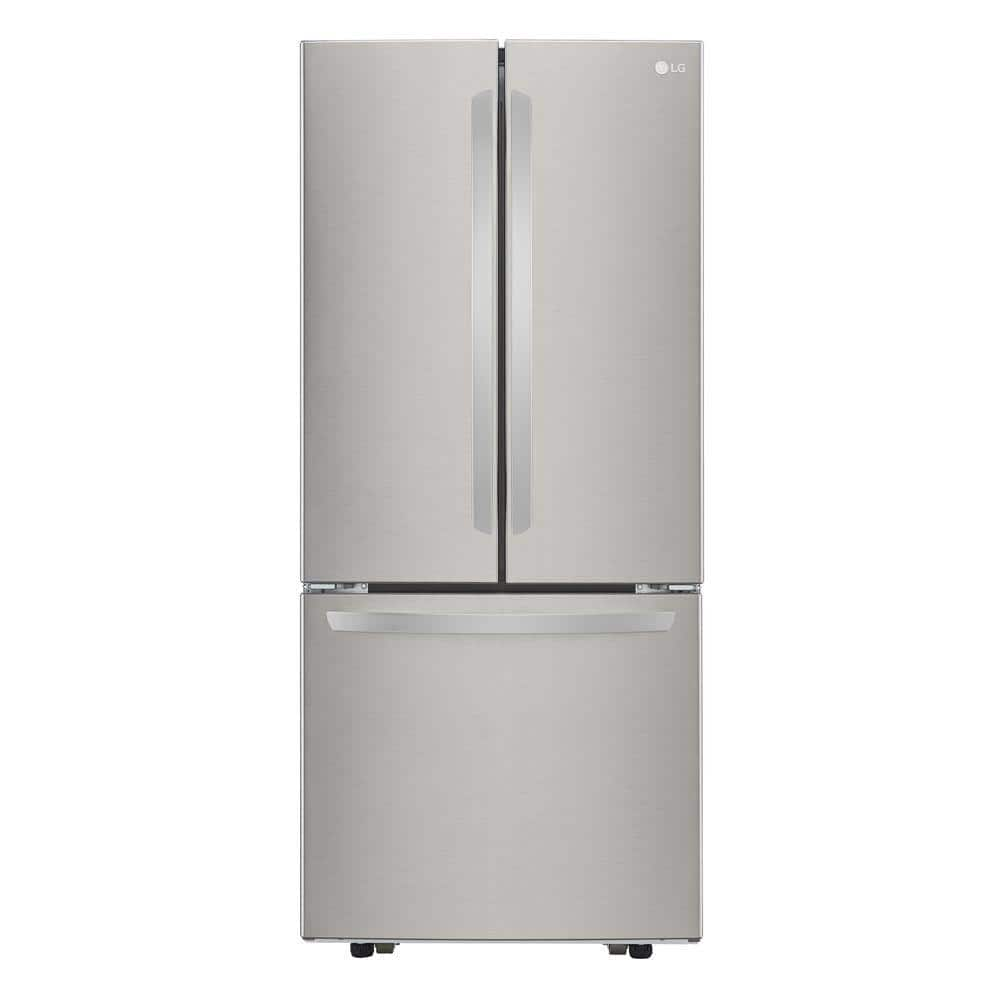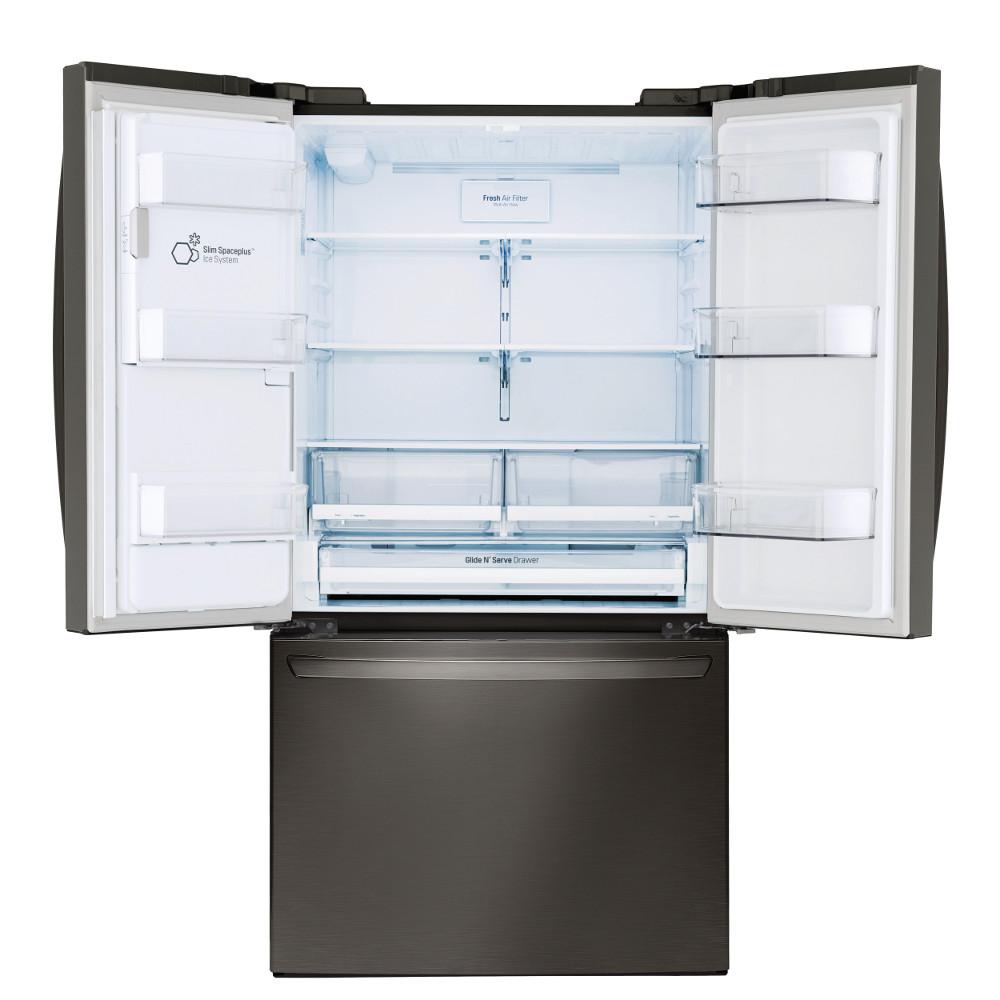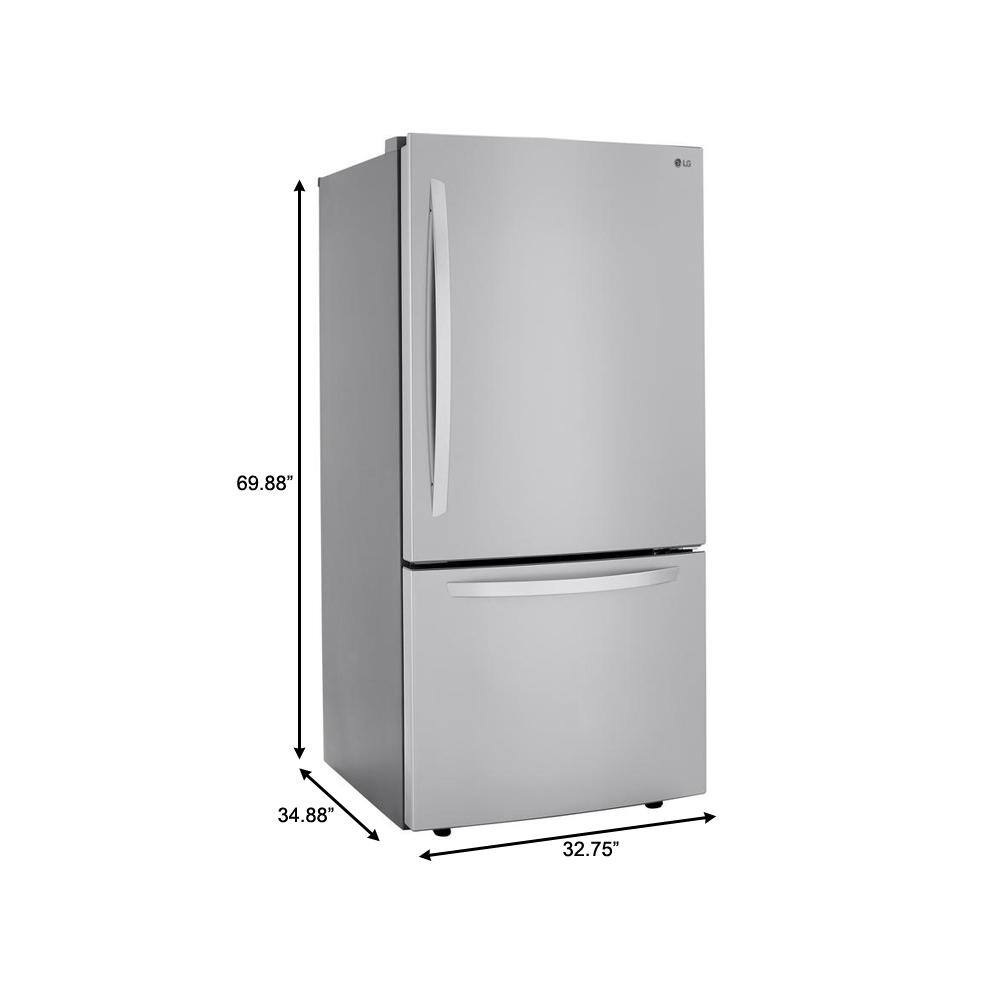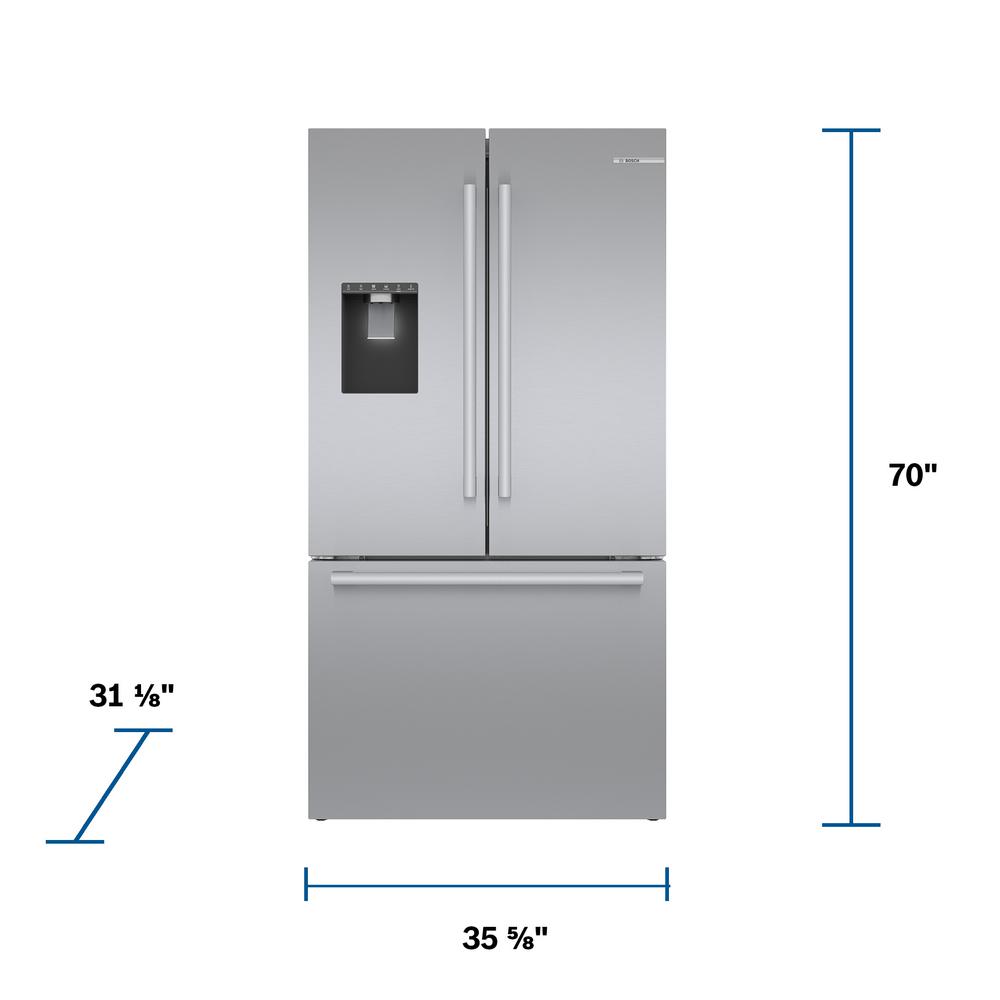LG Electronics 30 in. W 21.8 cu. ft. French Door Refrigerator in Stainless Steel
Smart Cooling system helps keep your food fresher, longer. Two crisper drawers give easy access to produce and beverages. 30 in. width fridge easily fits narrow and small kitchen spaces.
You don’t have to sacrifice style when shopping for smaller kitchen spaces. With a generous 21.8 cu. ft., LG’s stylish French door refrigerator gives you 10% more capacity in the same 30 in. Width. Not only does that mean more room for groceries, but Smart Cooling technology helps all that extra food stay fresher, longer.
- Save money and energy with this Energy Star-certified LG refrigerator that exceeds federal guidelines for energy efficiency
- The factory-installed ice maker provides you with a steady supply of ice any time you need it
- Up-front temperature controls make temperature management easy by placing the interior controls at the front of the refrigerator
- Smart cooling system: multi-Air Flow technology vents cold air on each shelf for more uniform temperature throughout the refrigerator; digital sensors are utilized to monitor refrigerator, freezer and room temperature to ensure consistent temperature for optimal food storage
- 2 humidity-controlled crispers optimize humidity, extending the life of most fruits and vegetables
- 6 adjustable Gallon-sized door bins to store your Gallon of milk or juice on the door, freeing up shelf space
- Large-capacity 14.5 cu. ft. fresh food capacity provides additional interior space, while 7.1 cu. ft. freezer capacity allows for additional storage space
- 10-year limited manufacturer warranty on linear compressor, which uses fewer moving parts and operates more efficiently for quieter performance
- Glide N’ serve drawer for added storage and versatility
- Premium recessed LEDs provide light in the fresh food section
- Energy Star
Additional information
| Depth (Excluding Handles) | 33.25 |
|---|---|
| Depth (Including Handles) | 35.5 |
| Depth (Less Door) | 29 |
| Depth With Door Open 90 Degrees (In) | 44.75 |
| Height to Top of Door Hinge (in.) | 68.5 |
| Height to Top of Refrigerator (in.) | 67.25 |
| Product Depth x Height x Width (in.) | 35.5 x 68.5 x 29.75 |
| Refrigerator Width (In.) | 29.75 |
| Certifications and Listings | CSA Listed,Energy Star |
| Manufacturer Warranty | 1 Year Parts & Labor, 5 Years Sealed System and Compressor, 6-10 Years Linear Compressor. |
Twenty-one, XXI or 21 may refer to:
- 21 (number), the natural number following 20 and preceding 22
- The years 21 BC, AD 21, 1921, 2021
30 may refer to:
- 30 (number), the natural number following 29 and preceding 31
- one of the years 30 BC, AD 30, 1930, 2030
A door is a hinged or otherwise movable barrier that allows ingress (entry) into and egress (exit) from an enclosure. The created opening in the wall is a doorway or portal. A door's essential and primary purpose is to provide security by controlling access to the doorway (portal). Conventionally, it is a panel that fits into the doorway of a building, room, or vehicle. Doors are generally made of a material suited to the door's task. They are commonly attached by hinges, but can move by other means, such as slides or counterbalancing.
The door may be able to move in various ways (at angles away from the doorway/portal, by sliding on a plane parallel to the frame, by folding in angles on a parallel plane, or by spinning along an axis at the center of the frame) to allow or prevent ingress or egress. In most cases, a door's interior matches its exterior side. But in other cases (e.g., a vehicle door) the two sides are radically different.
Many doors incorporate locking mechanisms to ensure that only some people can open them (such as with a key). Doors may have devices such as knockers or doorbells by which people outside announce their presence. Apart from providing access into and out of a space, doors may have the secondary functions of ensuring privacy by preventing unwanted attention from outsiders, of separating areas with different functions, of allowing light to pass into and out of a space, of controlling ventilation or air drafts so that interiors may be more effectively heated or cooled, of dampening noise, and of blocking the spread of fire.
Doors can have aesthetic, symbolic, ritualistic purposes. Receiving the key to a door can signify a change in status from outsider to insider. Doors and doorways frequently appear in literature and the arts with metaphorical or allegorical import as a portent of change.
Electronics is a scientific and engineering discipline that studies and applies the principles of physics to design, create, and operate devices that manipulate electrons and other electrically charged particles. It is a subfield of physics and electrical engineering which uses active devices such as transistors, diodes, and integrated circuits to control and amplify the flow of electric current and to convert it from one form to another, such as from alternating current (AC) to direct current (DC) or from analog signals to digital signals.
Electronic devices have hugely influenced the development of many aspects of modern society, such as telecommunications, entertainment, education, health care, industry, and security. The main driving force behind the advancement of electronics is the semiconductor industry, which in response to global demand continually produces ever-more sophisticated electronic devices and circuits. The semiconductor industry is one of the largest and most profitable sectors in the global economy, with annual revenues exceeding $481 billion in 2018. The electronics industry also encompasses other sectors that rely on electronic devices and systems, such as e-commerce, which generated over $29 trillion in online sales in 2017.
French may refer to:
- Something of, from, or related to France
- French language, which originated in France
- French people, a nation and ethnic group
- French cuisine, cooking traditions and practices
LG Corporation (or LG Group), formerly known as Lucky-Goldstar, is a South Korean multinational conglomerate founded by Koo In-hwoi and managed by successive generations of his family. It is the fourth-largest chaebol (family-run conglomerate) in South Korea. Its headquarters are in the LG Twin Towers building in Yeouido-dong, Yeongdeungpo District, Seoul. LG makes electronics, chemicals, household appliances, and telecommunications products and operates subsidiaries such as LG Electronics, Zenith, LG Display, LG Uplus, LG Innotek, LG Chem, and LG Energy Solution in over 80 countries. According to the “Top 500 Global Brands” released by British consulting firm Brand finance, LG's brand value ranking rose from 90th to 83rd from the previous year.
A refrigerator, commonly fridge, is a commercial and home appliance consisting of a thermally insulated compartment and a heat pump (mechanical, electronic or chemical) that transfers heat from its inside to its external environment so that its inside is cooled to a temperature below the room temperature. Refrigeration is an essential food storage technique around the world. The low temperature reduces the reproduction rate of bacteria, so the refrigerator lowers the rate of spoilage. A refrigerator maintains a temperature a few degrees above the freezing point of water. The optimal temperature range for perishable food storage is 3 to 5 °C (37 to 41 °F). A freezer is a specialized refrigerator, or portion of a refrigerator, that maintains its contents’ temperature below the freezing point of water. The refrigerator replaced the icebox, which had been a common household appliance for almost a century and a half. The United States Food and Drug Administration recommends that the refrigerator be kept at or below 4 °C (40 °F) and that the freezer be regulated at −18 °C (0 °F).
The first cooling systems for food involved ice. Artificial refrigeration began in the mid-1750s, and developed in the early 1800s. In 1834, the first working vapor-compression refrigeration, using the same technology seen in air conditioners, system was built. The first commercial ice-making machine was invented in 1854. In 1913, refrigerators for home use were invented. In 1923 Frigidaire introduced the first self-contained unit. The introduction of Freon in the 1920s expanded the refrigerator market during the 1930s. Home freezers as separate compartments (larger than necessary just for ice cubes) were introduced in 1940. Frozen foods, previously a luxury item, became commonplace.
Freezer units are used in households as well as in industry and commerce. Commercial refrigerator and freezer units were in use for almost 40 years prior to the common home models. The freezer-over-refrigerator style had been the basic style since the 1940s, until modern, side-by-side refrigerators broke the trend. A vapor compression cycle is used in most household refrigerators, refrigerator–freezers and freezers. Newer refrigerators may include automatic defrosting, chilled water, and ice from a dispenser in the door.
Domestic refrigerators and freezers for food storage are made in a range of sizes. Among the smallest are Peltier-type refrigerators designed to chill beverages. A large domestic refrigerator stands as tall as a person and may be about one metre (3 ft 3 in) wide with a capacity of 0.6 m3 (21 cu ft). Refrigerators and freezers may be free standing, or built into a kitchen. The refrigerator allows the modern household to keep food fresh for longer than before. Freezers allow people to buy perishable food in bulk and eat it at leisure, and make bulk purchases.
Stainless may refer to:
- Cleanliness, or the quality of being clean
- Stainless steel, a corrosion-resistant metal alloy
- Stainless Games, a British video game developer
- Stainless Broadcasting Company, a TV broadcaster based in Michigan, US
- Stainless Banner, the second national flag of the Confederate States of America
Steel is an alloy of iron and carbon with improved strength and fracture resistance compared to other forms of iron. Because of its high tensile strength and low cost, steel is one of the most commonly manufactured materials in the world. Steel is used in buildings, as concrete reinforcing rods, in bridges, infrastructure, tools, ships, trains, cars, bicycles, machines, electrical appliances, furniture, and weapons.
Iron is always the main element in steel, but many other elements may be present or added. Stainless steels, which are resistant to corrosion and oxidation, typically need an additional 11% chromium.
Iron is the base metal of steel. Depending on the temperature, it can take two crystalline forms (allotropic forms): body-centred cubic and face-centred cubic. The interaction of the allotropes of iron with the alloying elements, primarily carbon, gives steel and cast iron their range of unique properties. In pure iron, the crystal structure has relatively little resistance to the iron atoms slipping past one another, and so pure iron is quite ductile, or soft and easily formed. In steel, small amounts of carbon, other elements, and inclusions within the iron act as hardening agents that prevent the movement of dislocations.
The carbon in typical steel alloys may contribute up to 2.14% of its weight. Varying the amount of carbon and many other alloying elements, as well as controlling their chemical and physical makeup in the final steel (either as solute elements, or as precipitated phases), impedes the movement of the dislocations that make pure iron ductile, and thus controls and enhances its qualities. These qualities include the hardness, quenching behaviour, need for annealing, tempering behaviour, yield strength, and tensile strength of the resulting steel. The increase in steel's strength compared to pure iron is possible only by reducing iron's ductility.
Steel was produced in bloomery furnaces for thousands of years, but its large-scale, industrial use began only after more efficient production methods were devised in the 17th century, with the introduction of the blast furnace and production of crucible steel. This was followed by the Bessemer process in England in the mid-19th century, and then by the open-hearth furnace. With the invention of the Bessemer process, a new era of mass-produced steel began. Mild steel replaced wrought iron. The German states were the major steel producers in Europe in the 19th century. American steel production was centred in Pittsburgh, Bethlehem, Pennsylvania, and Cleveland until the late 20th century. Currently, world steel production is centered in China, which produced 54% of the world's steel in 2023.
Further refinements in the process, such as basic oxygen steelmaking (BOS), largely replaced earlier methods by further lowering the cost of production and increasing the quality of the final product. Today more than 1.6 billion tons of steel is produced annually. Modern steel is generally identified by various grades defined by assorted standards organizations. The modern steel industry is one of the largest manufacturing industries in the world, but also one of the most energy and greenhouse gas emission intense industries, contributing 8% of global emissions. However, steel is also very reusable: it is one of the world's most-recycled materials, with a recycling rate of over 60% globally.
W, or w, is the twenty-third letter of the Latin alphabet, used in the modern English alphabet, the alphabets of other western European languages and others worldwide. Its name in English is double-u, plural double-ues.






by Karen
Its prefect. I got it for my Daughter. she was just over joyed. I like the way its set up. The way it functions. Every thing about it seems this fine. The guys delivered move my old Refrigerator, put this one together and was off.
by Fidel
I am very happy is perfect thank you.
by Chris
This LG fridge is a great addition to my kitchen as I start to transition/update to stainless. I love the LED lights, the removed shelves inside and on the doors! Thank you HD and LG!!
by Alison
If you have a small space, this is your fridge. I love it. I replaced my traditional fridge in the bottom, freezer on the top with this beauty and I couldn’t be more happy. You don’t realize how much of a hassle those old fridges are until you get a new French door fridge. No more bending down and digging in the back, everything is at eye level. It’s quiet, only runs the compressor like once a day. The ice maker is quick and relatively quiet.
by Suzanne
We have had the refrigerator a couple of weeks now. Overall we are very pleased. The icemaker has a huge been so we never run out of ice! I wish the shelves could be reconfigured a little more so I could put a gallon of milk on the shelf and not in the door. We really like the look of the appliance. Some smudges on the handles but grubby fingers will do that! It’s actually darker on the inside than I thought it would be with the bright LED lighting. The lighting is in the front and gets blocked so it’s a little dark further back. I read a couple of reviews that said that this was a very solid refrigerator without lots of bells and whistle‘s. That’s all we wanted. Seems perfect for us. And I’m so happy that it came in a smaller size that fits our space and I do like the look of it!
by Melody
Love it. Makes my kitchen look so much bigger with all the shine. The only thing the skinny pull out drawer is freezing items in the very back. I not sure what temp to have frig or freezer. For some reason I’m having trouble keeping freezer front streak free but not the frig doors. With time I’ll figure it all out.
by Lemon
Plenty of space, super quiet, kicks out ice quickly, large freezer, lighting is bright, easy to adjust shelves. Unable to put magnets on front doors (stainless steel) but it looks better not junked up!
by James
I can’t give a definite review because it was a gift, so I am not using it. I was told they loved it and was very happy with it.